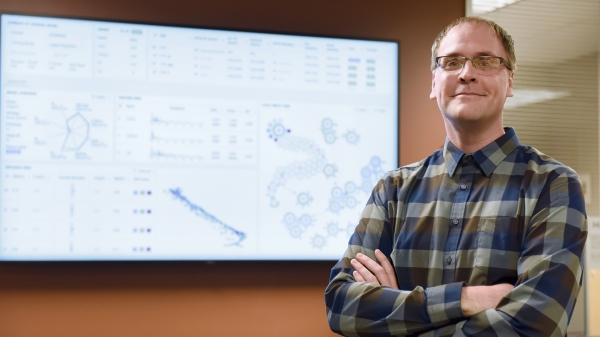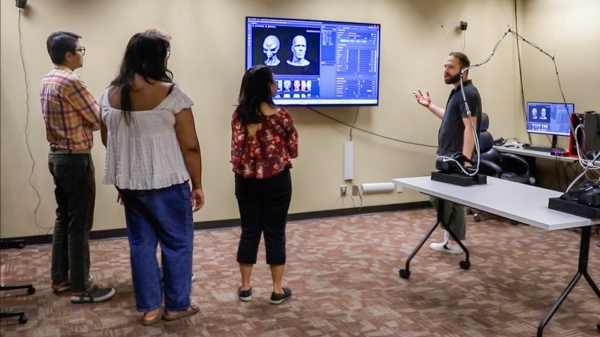ASU’s TweetTracker helps make sense of social media
TweetTracker is built in ASU's Data Mining and Machine Learning Lab led by professor Huan Liu (top row, middle). Photo by Jessica Hochreiter/ASU
There are 500 million tweets per day, and Arizona State University’s TweetTracker tool helps people to track, analyze and understand that activity by identifying the who, what, where and when of social-media usage.
TweetTracker is a Web-based system that collects and visualizes social-media data. It allows users to track events as they happen, collecting data from such sites as Twitter, Instagram, YouTube and VKontakte (the largest European social network). It also provides visualization capabilities such as graphs and maps to allow the user to understand properties of the events they track, such as which geographic regions are talking about each topic, and who the top users are in the context of the event.
“The goals of the system are to continue to support our users in both the domains of social science and crisis response,” says Fred Morstatter, a computer science graduate student in the Data Mining and Machine Learning Lab at ASU. “We do this by continually expanding the feature set of the tools.”
TweetTracker was started through a grant from the Office of Naval Research and was built at the Data Mining and Machine Learning Lab led by director Huan Liu, a computer science professor in the School of Computing, Informatics, and Decision Systems Engineering, one of the six Ira A. Fulton Schools of Engineering at ASU. The TweetTracker team was given the ASU President's Award for Innovation in 2014.
Tracking social media can help first responders understand what is unfolding on the ground during crises. The aggregate of social-media posts can give indications of what resources are needed. This can help increase the number of people who are given relief during crises.
“In 2012, we were training a group of analysts in the military to use TweetTracker,” Morstatter says. “During the training, a terrorist attack was carried out on the U.S. Embassy in Libya. We were able to help the analysts collect social-media data pertaining to the incident and understand what was going on in the region.
“When Hurricane Sandy hit in October 2012, we used the tool to collect data pertaining to evacuation efforts in New York and New Jersey. During the course of the storm we collected over 5 million tweets that were used to understand the effect of the storm. This data was used by agencies such as FEMA to analyze how users seek relief in times of disaster.”
Researchers also can use the tool to analyze the data and answer social-media questions. Universities across the globe have used TweetTracker to answer questions such as information diffusion and bias detection.
Data from TweetTracker has been used to find users tweeting from within crisis regions. One difficulty first responders have when viewing Twitter data is that very little (~1 percent) contains geographic information. By leveraging the data from TweetTracker, researchers proposed methods to find the geographic coordinates of the tweet by only looking at its text. This increases the number of tweets that first responders can look at when trying to understand what is going on in a crisis region.
Written by:
Erik Wirtanen, erik.wirtanen@asu.edu
480-727-1957
Ira A. Fulton Schools of Engineering
More Science and technology

ASU computing school director honored with prestigious award
Today, in an increasingly complex world, lawmakers and leaders must make big decisions, and they must often do so very quickly.…

Discovering new materials using AI and machine learning
The United States, in recent years, has been struggling with a supply shortage of critical materials needed for advanced…

ASU researchers experiment with breakthrough tech exploring human communication, perception
Digital manipulation of video images, whether for blockbuster films or malicious intent, also known as deepfakes, has become…